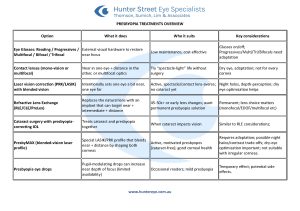
Beyond Readers: Modern Presbyopia Treatments
If your arms are “too short” and near tasks are getting fuzzy after 40, that’s presbyopia. It’s normal, and you have multiple ways to manage it – from simple glasses to surgical options like laser “blended vision” or lens implants. The best choice depends on your eyes, lifestyle, and tolerance for trade-offs (e.g., night-driving halos vs needing readers).
What is presbyopia?
Presbyopia is the age-related loss of the eye’s ability to shift focus up close. The natural lens stiffens over time, so near tasks (phone, labels, sewing) blur even if your distance vision is fine.
Typical timeline: starts mid-40s, progresses until mid-50s to early-60s, then stabilises.
Common signs
- You hold things further away to read
- Eye strain or headaches after near work
- Good distance vision but blurry near vision (especially in dim light)
Your main correction options
There’s no single “best” option – each involves trade-offs between clarity at different distances, night performance, comfort, and spectacle independence. We’ll help you match the option to your priorities.
AT-A-GLANCE COMPARISON

At Hunter Street Eye Specialists, we tailor your plan through a comprehensive assessment (tear film, corneal shape, ocular surface, pupil size, retinal health), lifestyle mapping (screen time, night driving, hobbies, reading), and demos where helpful (e.g., contact-lens monovision trials). We use shared decision-making to explain pros and cons – there’s no one-size-fits-all – and optimise dry eye to enhance comfort and visual quality for contacts, laser, and IOLs. Our surgeons, Dr Peter Sumich (cataract & refractive) and Dr Ridia Lim (glaucoma & cataract), consult in Parramatta and operate at local private day hospitals.
FAQs
Am I too young or too old for presbyopia correction?
Presbyopia starts mid-40s. Laser options suit many people in their 40s–50s without cataract. Lens-based solutions are often preferred in 50s–60s, or when cataract/early lens changes appear.
Will I definitely be glasses-free?
Not guaranteed. Many reduce dependence substantially; some still use readers for tiny print or long reading sessions, especially with monofocal strategies.
What about night-driving halos?
More common with multifocal IOLs and, to a lesser extent, after laser. We screen for risk factors and discuss mitigations (pupil size, lens choice, ocular surface care).
Is monovision right for me?
A short contact-lens trial is a great, low-risk way to test your tolerance before making it permanent with surgery.
Are presbyopia drops available?
Pupil-modulating drops used overseas provide temporary near improvement in selected patients. Availability in Australia is limited; ask us if you’re curious and we’ll advise case-by-case.
Ready to explore your options?
Book a personalised assessment in Parramatta with the team at Hunter Street Eye Specialists. We’ll measure your eyes, discuss your day-to-day visual tasks, and recommend the procedure most aligned to your goals.



